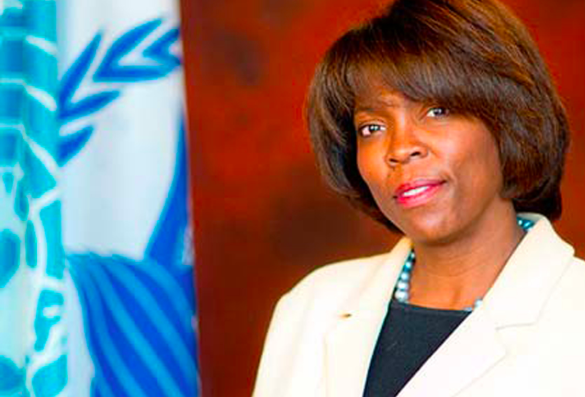
Ertharin Cousin is the Distinguished Fellow at the Center on Food Security and the Environment and the Center on Democracy, Development and the Rule of Law. Ertharin is also a Distinguished Fellow at the Chicago Council on Global Affairs. She previously served as executive director of the United Nation World Food Programme from 2012 until 2017 and the U.S. Ambassador for Food and Agriculture from 2009 until 2012.
ODP: You have said that people who struggle with food insecurity are “some of the strongest people you will ever meet. They are not vulnerable — they live in vulnerable places.” Can you explain?
EC: The data demonstrate, and my travels validate, that the most chronically food insecure people (outside of conflict areas) live in the places most affected by climate change. Despite this truth, these people continue to work their small farms or tend their cattle, only seeking assistance when the rains don’t come or the floods wash away their soil and seeds, leaving them without food or financial resources. I never met a mother or father who wanted to feed a child from food provided by the World Food Programme (WFP). They sought our assistance as a last resort when their livelihood activities failed.
ODP: What is the true extent of food insecurity risk around the globe due to climate change?
EC: The UN’s 2017 State of Food Insecurity reported an increase in the number of hungry people from 815 to 821 million. The report identified climate variability and extremes as one of the three primary drivers for this increase. The situation is worsening in South America and most regions of Africa; likewise, the decreasing trend in undernourishment in Asia, which has been a positive trend in recent years, is, unfortunately, slowing down significantly.
ODP: You ran the U.N.’s World Food Programme for several years. How did climate change impact your work over the course of your time there?
EC: Climate variability and extremes are now a key driver of food insecurity. For example, El Nino created erratic and more frequent rainfalls in 2016, resulting in emergency level acute food insecurity in Ethiopia and parts of southern Africa and Central America. In the Sahel, increases in food insecurity are directly related to the more frequent droughts. These are just two examples among many that my team and I experienced during my tenure at WFP.
ODP: We are the agricultural envy of the world in the U.S. and yet we still have a very high percentage of hungry people here. What can we do about that? How can our readers help?
EC: Too many Americans can’t afford nutritious food. In addition, some 20 million Americans live more than 2 miles from a grocery store — areas often referred to as food deserts. Where fresh foods are sold at all in these areas, their price points are well above the average costs. As a result, poor Americans choose diets of highly-processed or fast foods containing more sugar, fat, and salt. Malnourishment in the form of obesity is now resulting in rising rates of non-communicable diseases including diabetes and heart disease. Most alarmingly, rates of juvenile diabetes are rapidly increasing.
Your readers can help by ensuring that our legislators continue supporting the SNAP program, so that those without adequate income may access the safety net available for them to afford the nutritious foods required for healthy diets. To solve this over the long term, we can reframe this problem as an opportunity. There is an under-explored market to provide nutritious foods to poor and underserved populations. Whether through new technologies or business model innovations, I encourage businesses of all sizes to consider new models and products to reach those who are hungry with more healthy and sustainable diets.
ODP: What gives you the greatest hope, given all the stress that modern agriculture is putting on the land and water supplies on the planet today?
EC: What gives me the greatest hope is that people still care about the hungry child a world away as well as the hungry child here at home. Despite the current political environment, the issues of hunger and malnutrition retain bi-partisan support. While the suggested solutions may differ, we have several open avenues for reaching compromise on how we will address this challenge in our nation. This supports my pragmatic optimism that hunger is a solvable problem.
Thank you, Ertharin. We believe that our ODP readers do care about hungry children everywhere. Thank you for your work to stamp out hunger all over the globe.
February 4, 2019 » climate change, Drought, food, hunger, poverty, SNAP, World Food Organization, World Food Programme


